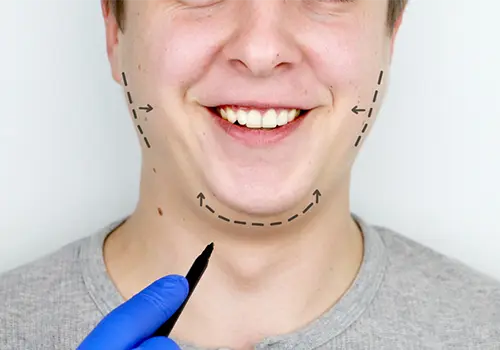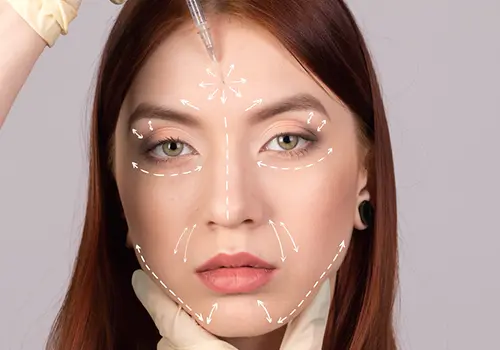Are you curious about transforming your facial profile? Chin Reshaping Surgery, or Genioplasty, is the key to achieving that perfect chin.
In this article, we’ll delve into Chin Reshaping, exploring what it is, its importance, and what you can expect to discover as you read on. Whether contemplating a subtle enhancement or a dramatic change, Chin Reshaping holds the answers you seek. If you’re ready to take the next step, “Dr. Maadico” can connect you with trusted surgeons in Iran and provide valuable guidance throughout your surgical journey. So, let’s get started on this journey to redefine your chin and boost your confidence.
What is Chin Reshaping Surgery in Iran?
Chin Reshaping is a cosmetic procedure designed to refine the shape and structure of your chin. This involves modifying the bone or adding an implant (chin augmentation) to achieve the desired shape, size, and symmetry.
Many people choose this procedure to correct a weak or prominent chin, improve facial balance, or enhance their overall appearance.
A well-proportioned chin complements your other facial features, such as your nose, lips, and eyes, creating a balanced and attractive appearance.
Types of Chin Reshaping Surgery in Iran
When it comes to Chin Reshaping Surgery or Mentoplasty, there are a few techniques in the playbook. Let’s take a closer look:
- Sliding Genioplasty: In this method, the surgeon cuts and repositions a segment of your chin bone. It’s fantastic for improving chin projection and contour.
- Chin Implants: If you’re not up for bone adjustments, consider Chin Enhancement. These soft, silicone wonders are inserted to create the desired chin shape.
- Reduction Genioplasty: Reduction Genioplasty or Chin reduction is for those who want to tone down a prominent chin. Here, a portion of the chin bone is removed to achieve a more refined and subtle look.
So, how do these techniques stack up against each other? It depends on your goals and what you’re comfortable with. Sliding Mentoplasty offers precise control and is ideal for augmenting chin projection. Chin Implants are versatile and less invasive, making them a popular choice. Reduction Mentoplasty or Chin reduction, on the other hand, is perfect for those seeking a more understated chin profile. The best option depends on your unique needs, and that’s where a skilled surgeon can guide you.

The Ideal Candidates for Chin Reshaping Surgery
Cosmetic Chin Surgery, or Genioplasty, can be a life-changing option for those who:
- Are dissatisfied with their chin’s shape or appearance.
- Have experienced an accident or injury affecting their chin’s aesthetics.
- Seek to improve facial balance and harmony.
- Have realistic expectations and a desire for increased self-confidence.
Before embarking on the journey of Genioplasty, a consultation with a qualified surgeon is paramount. Here are some questions that are typically asked during a consultation for Cosmetic Chin Surgery:
- What are your goals for chin reshaping, and what do you hope to achieve with this procedure?
- Have you had any previous surgeries or medical treatments on your chin or face?
- Are you currently taking any medications or supplements that might affect the surgery or your recovery?
- Do you have any existing medical conditions or allergies that the surgeon should be aware of?
- Have you experienced any significant trauma, injury, or accidents that have affected your chin’s appearance?
Red Flags about Chin Surgery
While Cosmetic Chin Surgery can work wonders, there are cases where it might not be suitable. Factors that could disqualify a person include:
- Severe health conditions like uncontrolled diabetes or heart disease may make surgery risky due to potential complications.
- Unrealistic goals, such as expecting a dramatic change from a subtle procedure or looking like a celebrity after the surgery, can lead to dissatisfaction because the anatomy of each individual is different and the result might be different for each person.
- Inability to follow post-op care instructions, like rest and diet, can hinder recovery.
- Specific anatomical features not matching procedure goals may limit effectiveness. For example, if someone has a receding chin but seeks a prominent chin, their anatomy may not align with those goals.
Remember, Mentoplasty is a personalized journey, and what’s right for one person may not be right for another. Your consultation will help determine if it’s the path to the chin you’ve always wanted.
The Chin Reshaping Surgery Procedure
Here’s a step-by-step guide to what happens during the procedure:
- Anesthesia: Your surgeon will use general anesthesia to put you to sleep or local anesthesia with sedation to numb the area. The choice depends on the extent of the surgery and your comfort.
- Incisions: Next, tiny incisions are made. For Sliding Genioplasty, these are often inside your mouth, so no visible scars are left. For Chin Implants, the incisions are usually made beneath the chin.
- Bone Adjustment or Implant Placement: In Sliding Genioplasty, your surgeon adjusts the chin bone by cutting, repositioning, and securing it. For Chin Enhancement, the silicone implant is placed and secured. Chin reduction involves removing a portion of the bone to achieve the desired shape.

Different Types of Implants used in Implant Placement
Surgeons can use various types of implants in chin enhancement procedures to achieve the desired aesthetic results. The choice of implant depends on the patient’s specific needs and goals. Here are some common types of implants used in chin enhancement:
- Silicone Implants: Silicone implants are the most frequently used for chin augmentation. They come in various shapes and sizes, allowing a customized approach to meet the patient’s desires. Silicone implants are known for their durability and ability to provide a natural look and feel.
- Medpor Implants: Medpor, short for “porous polyethylene,” is a biocompatible material used in chin implants. These implants have a porous structure that allows tissue and blood vessels to grow into the implant, providing stability and a secure fit.
- Gore-Tex Implants: Gore-Tex is a synthetic material often used for chin augmentation. It is biocompatible and has a porous structure, allowing for tissue integration. Gore-Tex implants are known for their flexibility and adaptability.
- Solid Silicone Elastomer Implants: These implants are made from solid silicone and are often chosen for their predictability and longevity. They provide a consistent and natural appearance.
- Bone Grafts: In some cases, surgeons may opt for autologous grafts, where the bone is taken from the patient’s own body (commonly the hip or rib) and used to augment the chin. This approach may be preferred for those who prefer using their tissue rather than synthetic implants.
- Biocompatible Polymer Implants: Biocompatible polymer implants are made from materials that the body readily accepts. They are a less commonly used option but can be suitable for certain patients.
Recovery and Postoperative Care
Right after your Cosmetic Chin Surgery, you’ll enter the recovery phase. Here’s what to expect:
- Immediate Effects: Some swelling and discomfort are common. Your chin may feel a bit tender.
- Dressings and Bandages: You might have dressings or a chin strap to minimize swelling and support your new chin shape.
- Diet: For a few days, you’ll likely stick to a soft diet to avoid pressure on your chin.
Recovery Time and Potential Side Effects
The timeline varies depending on the type of surgery:
- Chin augmentation: You’ll likely need a week or two off work. Swelling and discomfort usually peak in the first 48 hours and gradually subside.
- Sliding Genioplasty and Chin reduction: These might require a longer recovery time, with some swelling and bruising lingering for several weeks.
As for side effects, they can include swelling, bruising, temporary numbness, and mild discomfort. These are all part of the healing process and should improve over time.
Tips for a Smooth Recovery
To make your recovery as smooth as possible:
- Follow Postoperative Instructions: Your surgeon will provide specific postoperative guidelines. Adhering to these instructions is crucial. This includes taking prescribed medications as directed, attending follow-up appointments, and following any dietary restrictions.
- Rest and Sleep: Adequate rest is vital for healing. Try to get plenty of sleep, and when resting, keep your head elevated. This helps reduce swelling and discomfort. Using an extra pillow or a wedge pillow can make sleeping with your head elevated more comfortable.
- Cold Compresses: Applying cold compresses to the surgical area can help reduce swelling and discomfort. Make sure to follow your surgeon’s recommendations on how often and for how long to use cold compresses.
- Hydration: Staying well-hydrated is crucial for recovery. It helps with healing and can prevent complications. Aim to drink plenty of water, but avoid straws, as the suction motion can put pressure on the chin.
- Showering and Wound Care: Your surgeon will provide instructions on when it’s safe to shower. In the initial days, it’s crucial to keep the surgical area dry to prevent infection. Follow your surgeon’s advice on how to clean and care for the surgical site.
- Avoid Strenuous Activities: While it’s essential to stay active for circulation, avoid strenuous exercises and activities for the recommended period. Exertion can increase swelling and discomfort and hinder the healing process.
- Avoid Smoking and Alcohol: Smoking and alcohol can slow down the healing process and increase the risk of complications. It’s advisable to refrain from both during your recovery.
- Mind Your Medications: If prescribed pain medications or antibiotics, take them as directed. Be sure to discuss any allergies or adverse reactions with your surgeon.
- Stay in Touch: Don’t hesitate to contact your surgeon with any concerns or questions during your recovery. They are there to support you and address any issues that may arise.
Remember, every person’s recovery is unique, so don’t be alarmed if it takes longer than expected. Your surgeon will guide you to a more confident and harmonious chin.

Risks
Chin Reshaping Surgery can work wonders, but like any medical procedure, it has potential risks and complications. It’s essential to be aware of the following:
- Infection: There’s a small risk of infection at the surgical site, although it’s uncommon.
- Scarring: While incisions are usually discreet, there’s a possibility of noticeable scarring.
- Swelling and Bruising: Temporary swelling and bruising are normal, but they can be more pronounced for some individuals.
- Numbness: It’s common to experience temporary numbness in the chin or lower lip, which typically improves over time.
- Asymmetry: Achieving perfect symmetry can be challenging, and there’s a risk of slight asymmetry.
- Implant Issues: With chin implants, there’s a risk of implant shifting or complications with the implant material.
The best way to minimize these risks is to choose a highly qualified and experienced surgeon for your Chin Reshaping Surgery. Your surgeon’s skill and expertise are crucial in achieving safe and satisfying results.
Table of Cost Comparison for Chin Reshaping in Iran
Here’s a simplified table comparing the approximate price range for Chin Reshaping Surgery in Iran, Europe, and the USA. Please note that these are estimated ranges, and actual costs may vary depending on the surgeon, location, and specific case:
| Location | Price Range for Chin Reshaping Surgery |
| Iran | $1,000 – $3,000 |
| Europe (average) | $3,000 – $6,000 |
| USA (average) | $4,000 – $9,000 |
These price ranges include the surgeon’s fees, facility fees, anesthesia, pre-operative and post-operative care, and any additional costs associated with the procedure. It’s essential to research specific clinics and surgeons for accurate pricing and to consider factors like the surgeon’s experience and the level of care provided.
Final Takeaway
Chin Reshaping Surgery can be life-changing. We encourage you to gather information, ask questions, and, when you’re ready, make an informed decision that brings you closer to the chin you’ve always envisioned. Your journey to newfound confidence starts here!

If you’re ready for a change, request a free consultation.
You may also be interested in knowing about:
Facelift Surgery
Facial Bone Contouring
Chin Sculpting Procedures
Jawline Surgery
Facial Scar Revision
Cheek Dimple Creation
Forehead Reduction Procedure
Brow Bone Reduction
Buccal Fat Removal
Facial Feminization
Lip Enhancement
Ear Correction
Necklift
FAQs
- Is Chin Reshaping Surgery painful?
Discomfort and swelling are common after surgery, but pain is typically managed with medication.
- How long does the recovery process take?
Recovery varies, but most patients can return to normal activities within a few weeks.
- Are there age restrictions for the procedure?
There’s no strict age limit, but candidates should be in good health and have realistic expectations.
- Is Chin Reshaping Surgery dangerous for pregnant women?
It’s generally not recommended during pregnancy due to potential risks. Consult your surgeon for guidance and safe timing.
- Will the results of Chin Reshaping Surgery last a lifetime?
While results are long-lasting, factors like aging can influence the outcome over time. Maintenance may be needed in the future.
- Why Should I do the Chin Reshaping Surgery in Iran?
Iran is known for its highly skilled surgeons, advanced medical facilities, and affordable healthcare. Many international patients choose Iran for quality Chin Reshaping Surgery at a competitive cost. It’s essential to research and select a reputable clinic for your procedure.



